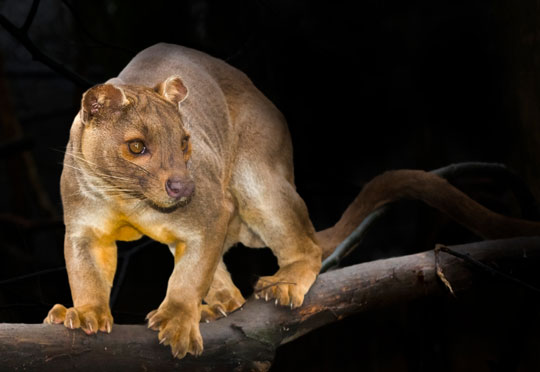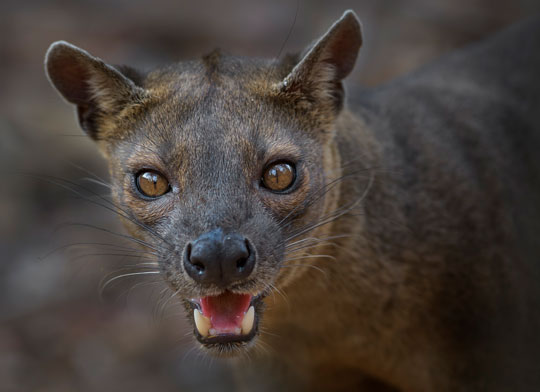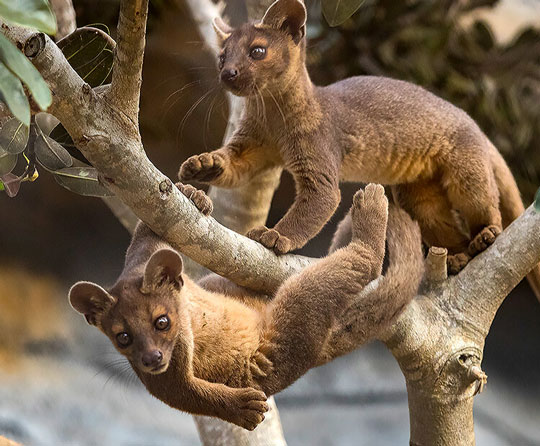|
My last post featured the Maned Wolf, a bizarre and little-known mammal. The Fossa also fits that description—a strange mammal that many people have not even heard of. What the heck is a Fossa? The fossa is not a cat (feline) or a dog (canine), although in some ways it resembles both. It is actually a relative of the mongoose. Fossas are medium-sized (15 to 26 pounds, or 7 to 12 kg) carnivorous mammals that live in the forests of the large African island of Madagascar, in the Indian Ocean. The name fossa is actually pronounced foo-sah, although many people also pronounce it as foosh. Amazing Facts about the Fossa The fossa is the largest carnivorous mammal native to Madagascar. Its total nose-to-tail-tip length is about six feet (1.8 m), with half of that length being its tail. As Madagascar's top predator, the fossa's favorite prey are various species of lemurs. In fact, fossas are often described as lemur specialists, and they can kill and eat lemurs that weigh 90% of the fossa's own weight. However, they also sometimes eat just about anything else they can catch, including small mammals (particularly rodents), birds, lizards, snakes, frogs, insects, crabs, and even fish. Most animals prefer to hunt either during the day or during the night, but the fossa seems to be happy hunting day and night. They also are just as skilled at hunting in trees as they are hunting on the ground. This ability to eat a variety of prey, as well as the ability to hunt anywhere and anytime, has helped the fossa to live in almost every habitat across Madagascar. Even so, in some areas they are extremely rare and seldom seen by people. When scientists studied the content of fossa droppings (which look like a cylinder with twisted ends... kind of like a Tootsie Roll wrapper), they also found seeds. The seeds may have been in the stomachs of the lemurs the fossas had eaten, but more likely they were seeds from fruits the fossas ate in order to get the water from the fruits. This last idea is supported by the fact that seeds are more common in the droppings during the dry season. The fossa's scientific name is Cryptoprocta ferox. Look at the genus name Cryptoprocta. Crypto means "hidden," and procta refers to the anus (think proctologist). So, this creature was named "hidden anus." Why? Well, the fossa has quite a few scent glands it uses for communication, especially for marking its territory. Some of these scent glands are just outside the anus, and they are enclosed within an anal pouch that encloses the anus, with a slit opening allowing the creature to defecate. So, the anus is hidden--Cryptoprocta! Fossas are apparently proud of their scent glands, and they love using them! They are solitary animals (except when mating and raising young), and they go to great lengths to mark their territories using their scent glands. They enthusiastically mark trees, rocks, grasses, and the ground. Each of these marks is basically a No Trespassing sign for other fossas. Okay, it's time to have "the talk." I'm referring, of course, to fossa mating habits. These creatures have some rather unusual reproductive strategies. Fossas are polyandrous, which means the females have more than one male mate (polyandry can be compared to polygyny, in which one male has multiple females). With the fossa, mating is all about the location. Mating typically takes place on a solid, horizontal tree branch, an average of 66 feet (20 m) above the ground. Yikes! That's a long way to fall, so this can be a dangerous activity. A particular tree branch will be used year after year, often by numerous females. Think of it as a singles bar, where young men and women go to hook up with a partner. Often, as many as eight males will hang around the spot, waiting for a female to show up. The females, who usually return to the same tree year after year, will arrive there one at a time, and each female will stay there for as long as a week. During that week, the female will mate with numerous males, one male at a time. The female chooses one of the males, signaling him with mewing sounds. Mating takes about three hours, and the process requires extreme acrobatic balance to prevent falling. After mating with the same male several times, which takes a total of about 14 hours, the female will signal another male that it's his turn. This goes on for up to a week, and then the female leaves the area, which means it's time for the next female to arrive and stay for another week, repeating the process. Unless you are offended by watching such things, check out this video of fossas mating. The female will give birth to up to six pups, which are very small, blind, toothless, and helpless. The pups do not become independent until they are a year old, and they are not sexually mature until they are three to four years old. As you can probably imagine, the pups are pretty darn cute. So, the Fossa deserves a place in the B.A.H.O.F. (Bonny Animal Hall of Fame). FUN FACT: The word bonny (or bonnie) originated in the mid 1400s. It's a Scottish adjective meaning "pleasing to the eye; handsome; pretty." The word is thought to have come from the Old French word bon, which means "good" (as in bon appétit, which literally means "good appetite"). The French word was in turn derived from the Latin word bonus, also meaning "good." Words derived from bonny include the adverb bonnily (the fossa ran bonnily through the forest) and the noun bonniness (the fossa possesses a great deal of bonniness). So, bonny is another way to say awesome! Photo Credits:
Fossa lying on its belly - DepositPhotos Fossa in tree with black background - DepositPhotos Fossa face - DepositPhotos Baby fossas - San Diego Zoo
1 Comment
Bles
1/6/2024 04:01:59 am
Super interesting article on an amazing animal that even I hadn't heard of despite working with and having studied animals haha
Reply
Leave a Reply. |
Stan's Cogitations
Everyone needs a creative outlet. That's why I write. Archives
April 2024
|





 RSS Feed
RSS Feed